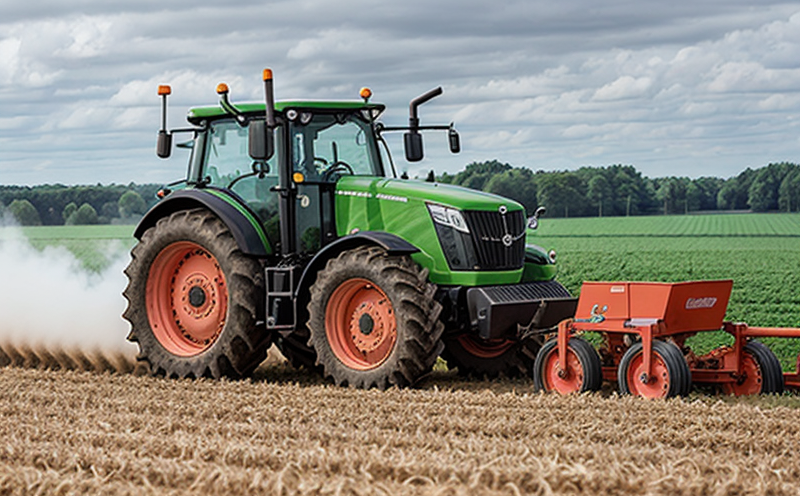Pesticide Spryer Droplet Size Distribution Testing
Testing pesticide sprayers to ensure optimal droplet size distribution is a critical aspect of agricultural machinery and equipment. The effectiveness of pesticides in achieving their intended effects depends on the size, shape, and uniformity of the droplets produced by spray nozzles. This service ensures that the sprayed material reaches its target accurately without causing unnecessary environmental or health impacts.
Droplet size distribution (DSD) testing is essential for several reasons. Firstly, it helps in determining whether the pesticide sprayer meets regulatory standards and industry best practices. Secondly, it aids R&D engineers in optimizing nozzle configurations to achieve desired spray patterns. Lastly, it ensures that the equipment performs consistently across various operating conditions.
The process involves capturing a representative sample of the spray output from the nozzles using specialized sampling devices. These samples are then analyzed using advanced analytical techniques such as laser diffraction or image analysis to determine the size distribution of droplets. The results provide insights into the uniformity and efficiency of the sprayer, which is vital for both environmental protection and operational effectiveness.
For accurate testing, it is important to follow standard procedures outlined in international standards like ISO 12985 and ASTM E374. These guidelines ensure that the test results are reliable and comparable across different manufacturers and regions. The use of appropriate sampling techniques ensures that the sample accurately represents the entire spray pattern.
The testing process typically involves several steps:
- Selection of representative nozzles based on their intended application.
- Setting up a controlled environment to simulate real-world spraying conditions.
- Sampling the spray output using an appropriate device designed for capturing droplets.
- Analyzing the samples using advanced analytical techniques such as laser diffraction or image analysis.
- Evaluating the results against established criteria and standards.
The outcome of this testing is crucial for several stakeholders, including quality managers who ensure compliance with regulatory requirements, R&D engineers who optimize nozzle configurations, and procurement teams that evaluate new equipment. By providing precise data on droplet size distribution, this service enables informed decision-making and continuous improvement in agricultural machinery.
Why Choose This Test
- Ensures compliance with international standards such as ISO 12985 and ASTM E374.
- Aids R&D engineers in optimizing nozzle configurations for better spray performance.
- Helps quality managers ensure that the equipment meets regulatory requirements.
- Provides insights into uniformity and efficiency of pesticide application, leading to improved operational effectiveness.
- Reduces unnecessary environmental impacts by ensuring accurate pesticide distribution.
Competitive Advantage and Market Impact
The ability to test droplet size distribution offers significant competitive advantages in the agricultural machinery sector. By offering precise data on spray performance, this service enables manufacturers to differentiate themselves through superior product quality and reliability. This not only enhances brand reputation but also attracts more discerning customers who value environmental responsibility.
In a highly regulated market where compliance with standards is non-negotiable, having accurate testing capabilities sets companies apart from their competitors. It demonstrates a commitment to both regulatory adherence and innovation, which are key factors in gaining market share.
From an operational perspective, ensuring consistent droplet size distribution can lead to improved crop health and yield. This translates directly into higher customer satisfaction and loyalty, further boosting a company's competitive position. By providing reliable data that supports these benefits, this service contributes significantly to the overall success of agricultural equipment manufacturers.
Use Cases and Application Examples
| Use Case | Description |
|---|---|
| R&D Optimization | Determining nozzle configurations that optimize spray patterns for different applications. |
| Regulatory Compliance | Ensuring equipment meets international standards such as ISO 12985 and ASTM E374. |
| Environmental Protection | Avoiding over-spraying or under-spraying, which can lead to inefficient pesticide use. |
| Economic Efficiency | Reducing waste by achieving precise application rates. |
| Application Example | Description |
|---|---|
| Precision Agriculture | Utilizing advanced technology to apply pesticides only where needed, minimizing environmental impact. |
| Crop Protection | Ensuring that the pesticide reaches its target uniformly for optimal protection against pests and diseases. |
| Eco-Friendly Solutions | Developing equipment that reduces pesticide drift while enhancing effectiveness. |





